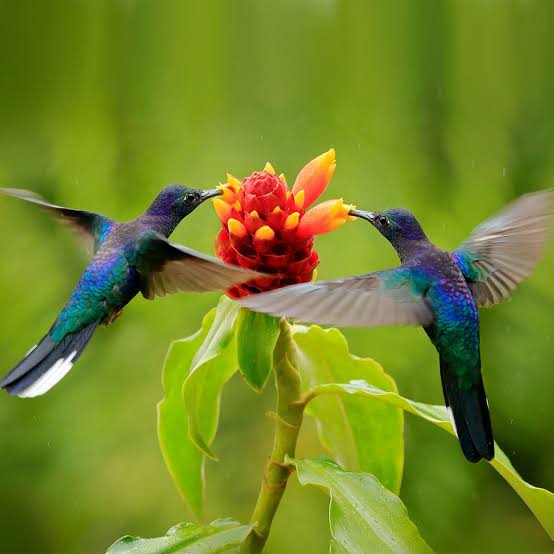National Hummingbird Day – September 3, 2022
National Hummingbird Day is celebrated on the first Saturday in September every year and this year it falls on September 3. Use this opportunity to educate yourself and others on how to care for, and support these amazing creatures, while also partaking in a variety of activities focused on them. Some communities celebrate this day with activities that include educational programs, hummingbird viewings, and field trips. Hummingbirds share the raising of the chicks and males live a lot shorter because they use so much energy in defending their nests. They use a lot of energy in flying and need to rest every 15 minutes, so we must make our gardens hummingbird friendly.
HISTORY OF NATIONAL HUMMINGBIRD DAY

The historical evolution of Hummingbirds has not been traced to any verifiable or scientifically researched source. Their first public sighting was published in a journal by a French explorer on his travels to Brazil. Their ability to have survived millions of years must have been difficult due to their size and structure. Hummingbirds, as beautiful and precious as they are, are only found in The Americas, especially in North and South America.
Hummingbirds are those small colorful birds distinguished by their ability to hover mid-air rapidly flapping their wings – which produces the humming sound they are characteristically known for. They are attracted to flowering plants, especially deep-throated flowers, and feed on the nectar for survival. Their reliance on nectar has helped the development of new hummingbird species influenced by the changes in the flowers.
The number of species is still growing, but about 360 species of Hummingbirds currently exist. Even with their aggressive nature, as many as 25 different pieces of Hummingbirds can survive and co-exist in the same place. The hummingbird’s size makes them susceptible to being preyed upon or caught in dangerous situations that could be man-made or natural. Some of these threats are pesticides, bad weather, big insects or predators, loss of habitat, and bad feeders, among others.
Even though these creatures have survived a long time without the direct and active intervention or help of man, this is currently changing as more information is being gathered on their vulnerability and threats to their survival. National Hummingbird Day exists to celebrate these beautiful flying creatures. It recognizes their importance in pollinating our flowers and identifies threats and situations that are harmful to them. It also encourages safer practices that will ensure their survival.
NATIONAL HUMMINGBIRD DAY TIMELINE
1557
Eulogized by a French Explorer
One of the first descriptions of hummingbirds is published by Jean de Léry.
1851
Part of a Royal Exhibition
More than 300 hummingbird species are exhibited in the Crystal Palace in London.
1918
Protected By Law
The Migratory Bird Treaty Act prohibits the domestication of migratory birds.
1950
Feed The Birds
Audubon Company introduces the first commercial hummingbird feeder.
NATIONAL HUMMINGBIRD DAY ACTIVITIES
Create awareness
Use your social media account to announce this holiday, and educate and encourage others to help the birds. This is especially important in your local community.
Grab an opportunity to see these creatures
Find gardens near you that host festivals and events dedicated to giving people the opportunity to see and hear hummingbirds. They usually arrange tours, so make sure you are there.
Watch a documentary
If you are unable to see these birds live, you can easily enjoy a detailed documentary that captures them in their natural habitat. Share the time with family and friends to make it more special.
5 INTERESTING FACTS ABOUT HUMMINGBIRDS
Their moonwalk is better than yours
They are the only birds that can fly backward.
A crowd is not their scene
They travel alone and don’t migrate in flocks like other species.
They are a bunch of flowers
Among other names, a flock of hummingbirds is called a bouquet.
They really like the Americas
Out of the 360 species of Hummingbirds, 330 are found in North and South America.
They are hangry
Their vulnerability to starvation causes them to be territorial and aggressive towards each other.
WHY WE LOVE NATIONAL HUMMINGBIRD DAY
An opportunity to raise funds
On this day, we love to see people show their understanding and care by donating to causes dedicated to the protection and conservation of hummingbirds. Volunteer at organizations dedicated to their preservation.
Appreciate nature
Nature can lift our mood. Use this opportunity to lift your spirits by watching and appreciating the beautiful creatures that exist.
It connects a community
Hummingbirds are flashy and beautiful jewel-like creatures, so we understand why everyone loves them. It promotes and connects the bird community.
NATIONAL HUMMINGBIRD DAY FAQS
Why are Hummingbirds aggressive?
Hummingbirds are territorial in nature and their aggression is intensified when their feeding areas are violated by other birds.
Where should I put a Hummingbird feeder?
To preserve the freshness of the nectar, position the feeder away from the sun, but in a spot that hummingbirds will easily see.
What is the lifespan of a hummingbird?
Hummingbirds live three to nine years.
Where do hummingbirds thrive?
The hummingbird is native to North, South, and Central America.



